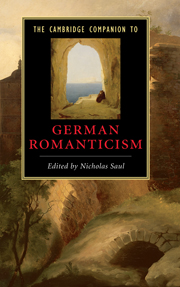Book contents
- Frontmatter
- 1 What is Romanticism, and where did it come from?
- 2 From early to late Romanticism
- 3 Prose fiction of the German Romantics
- 4 The Romantic lyric
- 5 The Romantic drama
- 6 Forms and objectives of Romantic criticism
- 7 Romanticism and Classicism
- 8 Women writers and Romanticism
- 9 The Romantics and other cultures
- 10 Love, death and Liebestod in German Romanticism
- 11 Romantic philosophy and religion
- 12 Romantic politics and society
- 13 Romantic science and psychology
- 14 German Romantic painters
- 15 Romanticism and music
- 16 Transformations of German Romanticism 1830-2000
- Key authors and their works
- Further reading
- Index
6 - Forms and objectives of Romantic criticism
Published online by Cambridge University Press: 28 September 2010
- Frontmatter
- 1 What is Romanticism, and where did it come from?
- 2 From early to late Romanticism
- 3 Prose fiction of the German Romantics
- 4 The Romantic lyric
- 5 The Romantic drama
- 6 Forms and objectives of Romantic criticism
- 7 Romanticism and Classicism
- 8 Women writers and Romanticism
- 9 The Romantics and other cultures
- 10 Love, death and Liebestod in German Romanticism
- 11 Romantic philosophy and religion
- 12 Romantic politics and society
- 13 Romantic science and psychology
- 14 German Romantic painters
- 15 Romanticism and music
- 16 Transformations of German Romanticism 1830-2000
- Key authors and their works
- Further reading
- Index
Summary
In his Kritische Fragmente (1797; Critical Fragments) Friedrich Schlegel famously remarked that the literary critic is just a reader who chews the cud. Hence he needs more than one stomach. Schlegel also asserted that modern poetry is a running commentary on the short philosophical proposition: 'All the arts should become science, and all science should become like the arts.' Thus the arts and sciences are inherently related. These two aphorisms encapsulate our core argument. The sciences and the arts were not only intimately interrelated for Romanticism, but their seemingly heterogeneous methods of inquiry - and by extension the art of criticism and its public dissemination - were also inseparable. Thus not only the critic, but also the reader, is best served by having more than one stomach, the better to digest such diverse fare. These aphorisms of course foreshadow Schlegel's even more famous Athenaeum Fragment No. 116 on the nature of Universalpoesie, which he characterises as a state of eternal becoming that can never be exhausted by theory and the inner essence of which can be accessed only by 'eine divinatorische Kritik' ('a divinatory criticism', Firchow, p.175; KFSA II, pp.182-3). This perception in turn lies behind his later, self-reflective judgement in the essay 'Über die Unverständlichkeit' (1800; 'On Incomprehensibility') on the forms and possibility of genuine communication between author and critic, text and reader. There he claims that his is a 'Zeitalter der Tendenzen' ('Age of Tendencies'), that is, an era in which all ideas and projects are best understood as constitutionally incomplete, caught up in an on-going dialectic that allows only preliminary conclusions.
- Type
- Chapter
- Information
- The Cambridge Companion to German Romanticism , pp. 101 - 118Publisher: Cambridge University PressPrint publication year: 2009
- 3
- Cited by

